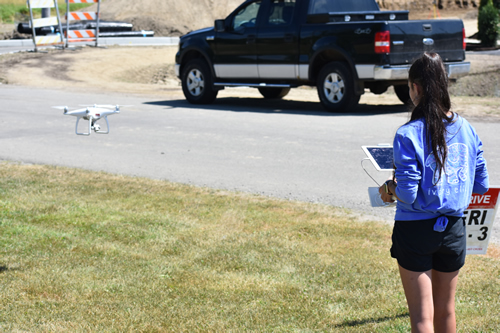As educators, we are all continuously looking for interdisciplinary learning opportunities that will provide students with the most authentic learning experiences possible. With students’ hyper-exposure to the growing applications for technology, STEAM programs are one area in which real-world applications are readily apparent to students.
Here in Salamanca, New York, as we seek to ensure our students have the necessary marketable skills for the modern economy, we’ve chosen to incorporate a drone curriculum into our STEAM programs. With the core drone skills, our students open themselves to employment opportunities in diverse sectors such as cinematography, industrial inspections, public safety, agriculture, construction, specialized sciences, and much more.
Drone education starts early on
To deliver on this goal for our students, we have developed a comprehensive drone curriculum that will introduce students to drones as early as kindergarten and allow them to become more hands-on throughout their academic career. For juniors and seniors, that experience culminates with an immersive curriculum through which they become FAA-certified drone pilots, while also imparting the core skills in data collection analysis necessary to pursue careers in this rapidly evolving workforce.
Like many districts, most of our best ideas start with our teachers. Three years ago, it became clear to a group of our forward-thinking educators that the proliferation of drones offered a path not only to the workforce but for our students to contribute to their community. As a rural, small city school district nestled by the Allegany State Park, we saw opportunities for our students to work alongside law enforcement in search-and-rescue operations or assist local university researchers in land-surveying operations.
With little initial guidance on how to most effectively develop a drone-focused curriculum, we learned a few important lessons that other districts can apply should they choose to adopt drone training into their STEAM programs.
4 keys to developing a drone curriculum
1. Know your strengths
Initially, we brought in drone trainers to teach our teachers how to fly drones, enabling them to secure the necessary FAA Part 107 license. We quickly realized there was a lot more to the comprehensive curriculum we envisioned than simply having teachers that could pilot drones. While purchasing curricula is not always the ideal solution, we recognized that this was a case where the added expertise was necessary to develop a truly rich curriculum.
A serendipitous conversation with a colleague led us to SkyOp LLC, which has been training commercial drone instructors for years and had recently started to work with a local community college to incorporate drone training into its curriculum. Ultimately, the SkyOp Drone Training Curriculum gave us the tools we needed to provide the authentic learning experiences we and our students demanded.
While preparing students for the FAA Part 107 pilot exam is an initial objective of the curriculum, the customizable curriculum also incorporates hands-on flying time as well as work with the key data collection and analysis tools students will need in the drone industry. The industry’s rapid advancement meant the teaching resources also had to evolve to match, so SkyOp incorporated a learning management system that is updated in real time to ensure instructors are teaching from the most up-to-date course materials, drone regulations, etc.
Ultimately, we developed a semester-long elective course for juniors and seniors that combines daily 40-minute in-class lessons with dedicated flight time after school, and access to a drone so students can practice around their busy schedules.
2. Policy implications
With the curriculum components confirmed, there were still some administrative hurdles to surpass. Because drone integration in education was still a relatively new concept, we needed to develop a district-wide policy for the use of drones. Of course, that policy was subject to legal requirements and, ultimately, the approval of our school board.
We were fortunate to have district administrators and school board members who immediately saw the same opportunity in drone applications and worked diligently to make our vision a reality. Since we traversed those administrative issues, there are now numerous model policies available to districts looking to incorporate drones in their area.
3. Educating the insurers
Another lesson we learned was the importance of educating our insurance carrier on the very specific ways our new policy would play out. It should be no surprise that the insurer first balked at covering the potential liabilities. But once we helped them understand prioritization of safety measures, the insurer was able to make the necessary accommodations. Again, as drones become more commonplace in educational settings, this resistance should change as well, but the expertise of our curriculum partners at SkyOp has been very helpful in securing those approvals and ultimately the coverage we needed.
4. IT implications
With all else in place, there was still one more hurdle to surpass. As mentioned earlier, simply teaching students to fly a drone is only part of the skill set they will need in the drone industries. They also need experience in data collection and hands-on time with the data analysis, photogrammetry, and 3D mapping tools common in the market. The challenge for our IT team was to ensure our lab hardware was up to running those data-rich and processor-heavy applications, all while accommodating the massive volumes of data storage the students and instructors would require.
In all, the deployment of this drone-focused STEAM curriculum took a district-wide effort from the passionate teachers who first saw its potential to the administrative team as well as our elected officials and even some knowledgeable outside partners. Today, the first cohort of juniors and seniors is making its way through the program, with confidence that they will be ready to take on the challenges of the modern-day workforce.
- 4 ways to encourage play in education - April 25, 2024
- CoSN IT Leader Spotlight: Lisa Higgins - April 25, 2024
- It’s time to pay student teachers - April 25, 2024

